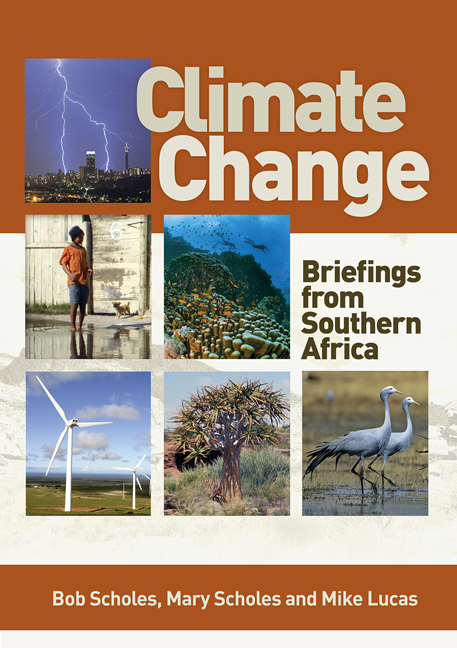Book contents
- Frontmatter
- Acknowledgements
- Contents
- Foreword
- Acronyms and abbreviations
- Preface
- How do governments assess climate change?
- Section 1 Earth system science: The processes that underlie climate change
- Section 2 Consequences of a changing climate for the Southern African environment
- Introduction
- 1 How resilient are ecosystems to climate change?
- 2 How will South Africa's plants respond to climate change?
- 3 Could rising carbon dioxide concentrations boost plant growth?
- 4 Is bush encroachment caused by global change?
- 5 Will South Africa's land animals cope with climate change?
- 6 Are South Africa's birds taking flight?
- 7 Will South Africa run out of water?
- 8 How will climate change affect freshwater ecosystems?
- 9 How much, and how fast, will sea level rise?
- 10 What is ocean acidification?
- 11 How will ocean acidification affect marine organisms?
- 12 How is climate change affecting South Africa's coastal seas?
- 13 How is our marine life responding to climate change?
- 14 Will coral reefs survive climate change?
- 15 Are South Africa's Prince Edward Islands vulnerable to climate change?
- 16 How are Antarctica and the Southern Ocean responding to climate change?
- Section 3 Consequences of a changing climate for society
- Section 4 What we can do to avoid and adapt to climate change
- Codicil Is there a dangerous level of climate change?
- Glossary
- List of figures
- References
- Reading list
- Index
5 - Will South Africa's land animals cope with climate change?
from Section 2 - Consequences of a changing climate for the Southern African environment
Published online by Cambridge University Press: 20 April 2018
- Frontmatter
- Acknowledgements
- Contents
- Foreword
- Acronyms and abbreviations
- Preface
- How do governments assess climate change?
- Section 1 Earth system science: The processes that underlie climate change
- Section 2 Consequences of a changing climate for the Southern African environment
- Introduction
- 1 How resilient are ecosystems to climate change?
- 2 How will South Africa's plants respond to climate change?
- 3 Could rising carbon dioxide concentrations boost plant growth?
- 4 Is bush encroachment caused by global change?
- 5 Will South Africa's land animals cope with climate change?
- 6 Are South Africa's birds taking flight?
- 7 Will South Africa run out of water?
- 8 How will climate change affect freshwater ecosystems?
- 9 How much, and how fast, will sea level rise?
- 10 What is ocean acidification?
- 11 How will ocean acidification affect marine organisms?
- 12 How is climate change affecting South Africa's coastal seas?
- 13 How is our marine life responding to climate change?
- 14 Will coral reefs survive climate change?
- 15 Are South Africa's Prince Edward Islands vulnerable to climate change?
- 16 How are Antarctica and the Southern Ocean responding to climate change?
- Section 3 Consequences of a changing climate for society
- Section 4 What we can do to avoid and adapt to climate change
- Codicil Is there a dangerous level of climate change?
- Glossary
- List of figures
- References
- Reading list
- Index
Summary
Many animal species are already responding to climate change by altering their geographic distribution and seasonal behaviour. Rapid climate change may challenge even relatively mobile and adaptable animals.
Terrestrial vertebrate species include mammals and birds, which maintain their body temperature nearly constant around 37°C regardless of the ambient temperature, and reptiles and amphibians which do not. Homeotherm species (those that keep their temperature constant, sometimes called ‘warm-blooded’) are able to colonize places cooler than is optimum for animal physiology, but become progressively less able to regulate their temperature as the air temperature approaches or exceeds their body temperature. Poikilotherm (variable temperature or ‘cold-blooded’) species become quite sluggish in the cold and are much more active in warm places. They also adjust their body temperature, but mainly by changing their behaviour rather than their metabolism. Both warm- and cold-blooded species have upper and lower thermal limits, beyond which they are severely impaired or even die.
In South Africa there are many museum records of where plants, mammals, birds, reptiles and various species of insects occurred in the past. Amateur naturalists’ notes add to the record of where species have been seen and are currently distributed. Around the world it has been observed that many species are now found closer to the poles, or higher up mountains, than where they were first recorded. How fast and how far they have moved depends on whether they are highly mobile organisms, such as birds, or species fixed to one spot for their lifetime, such as plants.
In South Africa, warm-area birds such as the African paradise flycatcher and the crimson-breasted shrike, found historically in the Low-veld, are now commonly observed in previously cooler places, such as the Highveld. There are several factors contributing to these changes, including bush encroachment (see Sec. 2, Q4) and the creation of ‘urban forests’ in Highveld cities, but climate change is very likely one of the causes. Section 2, Question 6 discusses changes in bird distribution more comprehensively.
Mammals are also relatively mobile so, in theory, they can migrate to remain in their preferred environmental conditions. The problem many face is loss of suitable habitat to migrate into. Large reserves such as the Kruger National Park provide space for many animals to move, but even it does not provide the climate range needed.
- Type
- Chapter
- Information
- Climate ChangeBriefings from Southern Africa, pp. 66 - 67Publisher: Wits University PressPrint publication year: 2015



